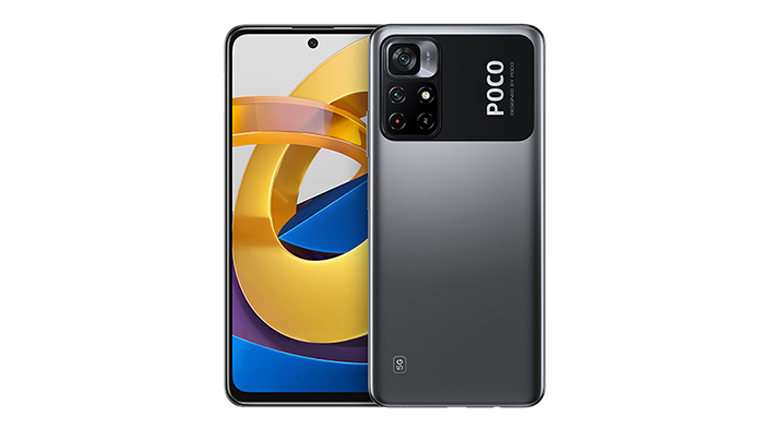This doesn’t feel like a premium handset to hold – there’s no cool metallic touch when you pick up the phone, for example. Still, my Power Black review unit had a nice reflective finish to the plastic backplate. There’s a Cool Blue version and what looks like a rather arresting Poco Yellow model, too.
Whatever colour you go for, the rear camera array sits in a raised lozenge that is itself surrounded by a huge black Poco-branded strip. It’s certainly an arresting design, but it may not appeal to everyone.
The right edge houses a volume rocker and the power button, which incorporates a fingerprint reader. Face authentication is also available if you prefer. There’s a 3.5mm headset jack on the bottom edge for those who don’t want to use a Bluetooth or USB-C connection.
This handset benefits from a moderate level of dust and water resistance: IP53 certification signifies that it’s ‘dust protected’ and can handle ‘spraying water’.
The 6.6-inch screen has a resolution of 2,400 by 1,080 pixels (399ppi). The IPS panel is clear and sharp, and offers a variety of settings: vivid, saturated and standard colour schemes; default, warm, cool and custom colour temperatures; and a reading mode that adjusts the colours so that they’re easier on the eye. The refresh rate can be set to either 60Hz or 90Hz, with the higher rate preferable for content like video watching or gaming (although using it will drain the battery quicker).
The Poco M4 Pro 5G has a 5000mAh battery and 33W fast charging. I could get through a day without needing to charge the battery halfway through, often ending the day with around 40% left. Poco says a full charge can be delivered in an hour. Setting the handset up to charge first thing in the morning meant it was at 100% by the time I was ready to check the news and get on with my day. For the record, Poco says a full battery will provide 12 hours of gaming, 179 hours of music, 16 hours of video playback or 33 hours of reading.
There are two speakers, but the sound they deliver is fairly tinny and hollow. There’s plenty of volume, but if you like to actually hear bass tones, we’d recommend a headset.
Budget phones often compromise on the cameras, and that’s the case here. On the front, sitting inside a central punch-hole, there’s a 16MP f/2.45 camera that shoots a decent enough selfie.
At first glance, it looks as though there are as many as five cameras at the back. However, one circular frame holds an AI label, another a red dot, and another the flash unit. This leaves two actual cameras: 50MP f/1.8 wide-angle and 8MP f/2.2 ultra-wide-angle. It can take a while for the focus to settle, and you can’t get very close to your subject, but 10x digital zoom is available. It’s all quite basic point-and-click fare.
The mainstream MediaTek Dimensity 810 processor with 6GB of RAM pushes things along nicely – I didn’t feel let down in terms of performance, especially considering this handset’s budget price. There’s 128GB of storage, 24GB of which is used out of the box, leaving 104GB free; you can also use a MicroSD card in the second SIM slot if more storage is needed. The Geekbench 5 CPU benchmark reported an average multi core score of 1804 and a single core score of 593. By way of comparison, top-end flagship handsets score around 3000 (multi core) and 1000 (single core).
Android 11 is overlain by MIUI 12.5, and Poco provides quite a lot of added software on top of the Android staples. Not all of it will be of use to everyone. Some of the Poco apps are in folders and some are presented as standalone icons, and much of it can’t be deleted. This abundance of third-party apps is a drawback for this handset.
SEE: Got Windows and an Android handset? Microsoft just updated its Your Phone app
As a budget 5G phone, the Poco M4 Pro 5G performs well and supports two 5G SIMs if need be. Otherwise, you can put a MicroSD card in the second SIM slot. The good screen and decent battery life are plus points, while the drawbacks include an average camera array and an abundance of added software.
RECENT AND RELATED CONTENT
Q3 smartphone sales fall 6.8% as demand outstrips component supplies
Xiaomi Q3 sees steady smartphone revenue as investments pummel net profit
Best cheap phones 2022: 5G and flagship features for under $400
Android 12 and iOS 15 offer a glimpse of what’s to come in phone tech in 2022
Read more reviews
Insta360 One X2 camera review: Capture everything, edit and share laterINNOCN PU15-Pre 4K OLED review: A portable monitor to improve your productivityMoto Watch 100 review: An exercise in frustration not worth the $100 priceGlowforge Pro review: Laser cutting and engraving for serious hobbyists and makersZhiyun Smooth 5 review: Professional level gimbal for content creators
